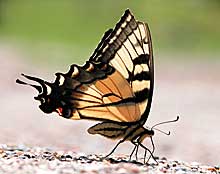  |
| HOME | THIS ISSUE | CALENDAR | GRANTS | BACK ISSUES | < BACK | NEXT > |
Nature lover’s photographs on display at Babbidge Libraryby Kala Kachmar - June 18, 2007 | ||||
| When Paul Swiacke jokingly asked library curator David Avery if he could hang his amateur photographs on the walls he so often touches up with paint, Avery took him seriously. Swiacke, who holds a degree in biology from UConn and has worked in Facilities Operations for 20 years, showed Avery a small sample of his 8,000 candid nature photographs.
And the two began to plan for an exhibit of Swiacke’s work that is now on display in the Stevens Gallery at Homer Babbidge Library until Aug. 17. “Paul really has an eye for photography,” Avery says. “There’s something about his photos that makes them seem so real and alive.” Swiacke’s photos, inspired by his love of nature, were taken almost exclusively in New England. His photographs depict such images as trees arched over a sparkling river with a triangle of sunlight illuminating the foreground, or a dragonfly with faint black stripes on its screened wings grasping a twig with lush, budding leaves behind it. “His pictures say it all. They make you stop and say, ‘I know that place,’” Avery says. “One of his photos is taken on the Moosup River, where I fish,” he adds. “When I saw the image, it struck me as familiar, and then I realized where it was taken.” Swiacke hand built the frames for the 10 large images and 58 smaller ones that are displayed in an arrangement he designed himself in the gallery. The 8-by-10 photos were printed on his own inkjet printer, while the 11-by-17 photos were sent to a digital imaging lab. This is the first public exhibition of Swiacke’s work. “I don’t consider myself an artist,” he says. “I shoot what I like and what’s available to me: nature.” Swiacke spends most of his free time canoeing, fishing, and backpacking. He takes photos along the way. “Taking photos of nature is just an extension of what I do outside,” he says. “It gives me something to do other than stand in a river all day and fish.” Most of the photos were taken in various locations around New England, with many from places in Connecticut including Pachaug State Forest in Voluntown, Bluff Point in Groton, and the Thames River in Norwich. “I took some of them in my backyard,” says Swiacke, who lives in Plainfield. Some were also taken in the Adirondack Mountains in Keene, N.Y. In the past, Swiacke has shot photographs in the Grand Canyon, Mammoth Cave National Park in Kentucky, and the White Mountains with a traditional camera using film. Swiacke has a long-standing interest in photography, but he hadn’t photographed anything in 30 years until three years ago, when he took an old 35mm camera on a trip to Alaska with his son. The trip inspired him to learn how to use a digital camera. “I watched people who were using digital cameras,” Swiacke says. “When they were done taking the photos, they were done. I still had to have mine processed.” Since that trip, Swiacke has taken more than 8,000 digital photos with a 5.0 megapixel Nikon Coolpix 5700. He recently purchased a digital 35mm Nikon D200 that he is still learning how to use. “I’m completely self-taught,” he says. “It took me six or eight months to figure out digital cameras.” When going on outdoor trips, he carries only his small digital camera with him in case he decides to take photos. When his primary purpose is to take photos, he travels to places he’s already been, bringing along the more bulky 35mm digital camera. He says he doesn’t make a lot of adjustments to his photos, but does use Adobe Photoshop Elements 3.0 to sharpen them, clean the edges, and adjust the lighting, if necessary. “I don’t add any color or make any digital changes to the photos,” he says. Swiacke has sold a few 8-by-10s and plans to submit his photos to a nature photography contest. “I’m going to do it for fun and see where it goes,” he says. “But I don’t plan to get rich from it.” |
| ADVANCE HOME UCONN HOME |

